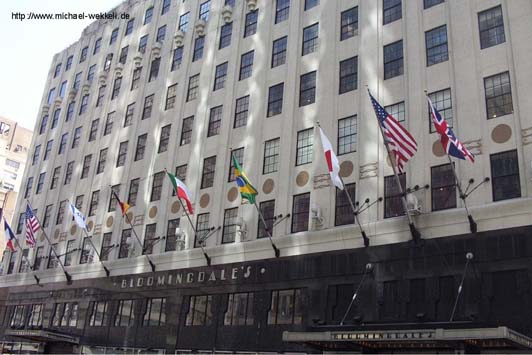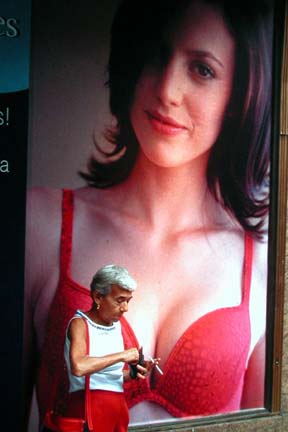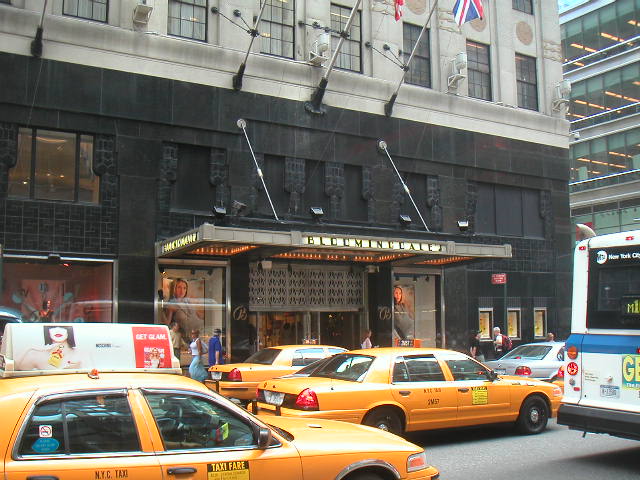 |
New York
Architecture Images-Upper East Side Bloomingdale’s |
|
architect |
|
|
location |
Lexington, Third AvenUES0, E59, E60. |
|
date |
1931 |
|
style |
Art Deco |
|
construction |
|
|
type |
Shop |
|
|
|
|
images |
  |
 |
|
|
|
1860s - a store is born To think that it all started with a 19th century fad - the hoop skirt. That was the first item that Joseph and Lyman Bloomingdale carried in their Ladies' Notions Shop in New York's Lower East Side. 1870s - something for everyone 1880-1929 - moving up in the world 1900-1910 - read all about it 1940s - lights - camera - action! 1960s - it's in the bag 1970s - not a store but a
destination 2000+ - looking foward |
|
notes |
NEW YORK,
NY...Bloomingdale's began with a 19th century fad, and the extraordinary
vision of two brothers. Lyman and Joseph Bloomingdale pioneered nearly
every major change in the evolution of department stores - if they weren't
the first with an idea, they simply did it bigger and better than anyone
else. Their innovative retailing philosophy guided Bloomingdale's in its
beginning and that philosophy continues today, justifiably earning
Bloomingdale's the reference "Like No Other Store in the World,"
The first retail endeavor of the Bloomingdale's brothers was a Ladies' Notion Shop in New York. In 1872, Bloomingdale's expanded and opened their East Side Bazaar, selling a variety of women's fashions. This was a bold move in the era of specialty shops; the Bazaar became a harbinger of the true "department store." By 1929, Bloomingdale's covered an entire city block. Two years later, the glamorous Art Deco edifice that still graces Lexington Avenue was completed. In 1949, Bloomingdale's began its real expansion, opening its first satellite store in Fresh Meadows, Queens and by 1959, Bloomingdale's had created a complete circle of stores around the flagship, in New Jersey, Westchester County and Long Island. This dramatic growth continued in the 70's and 80's with the opening of stores in the Northeast, Florida, and Chicago. Bloomingdale's was on its way to becoming a true national entity. That vision culminated in November 1996 with the addition of its first four stores in California, the most ambitious expansion in the company's history. From the beginning, the Bloomingdale's brothers catered to America's love of international goods, and by the 1880's, their European selection was dazzling. A buying office in Paris in 1886 was the beginning of a network that now spans the globe. The 1960's brought promotions resulting from Bloomingdale's fascination with the foreign market: the first was a small affair called "Casa Bella" featuring merchandise for the home from Italy. Over the next thirty years, the promotions took on a grand scale - including unique merchandise and cultural exhibits that would touch every department in Bloomingdale's. Major transformation of the Bloomingdale's image came in the 1960's and 70's. The promotions were so exciting that the term "Retailing as Theater" was coined to describe Bloomingdale's "happenings." It was the era of pet rocks and glacial ice cubes, of visits by movie stars and royalty, from Elizabeth Taylor to Queen Elizabeth II. The new direction in merchandising was both to seek and to create. Buyers covered the globe to find exclusive, one-of-a-kind items. When they couldn't find what they wanted, they had it made. In fashion, Bloomingdale's launched new designers and created boutiques for already-famous names. Among the discoveries: Ralph Lauren, Perry Ellis and Norma Kamali - and for the first time in America: Sonia Rykiel, Kenzo and Fendi ready-to-wear. Designers opening their first in-store boutiques at Bloomingdale's include Yves St. Laurent, Calvin Klein, Claude Montana and Thierry Mugler. In 1961, Bloomingdale's made retail history in yet another area by introducing the first designer shopping bag. Artist Joseph Kinigstein was commissioned to create a bag for the "Esprit de France" promotion. Rather than doing the obvious - ladylike flowers in pastel colors - he reproduced antique French tarot cards in bold red, black and white. Most daring of all, the bag omitted the store name. Even so, it was unmistakably Bloomingdale's, and the collector's shopping bag was launched. Since then, Bloomingdale's bags have been created by both famous and fledgling artists, architects and ad designers. Their designs have been featured in art museums all over the world. In 1971 "model rooms", a highlight of Bloomingdale's since 1947, gained worldwide attention. "The Cave," an intricate multi-level frame sprayed entirely in white polyurethane, was a spectacular example of the lengths to which Bloomingdale's would go to make a statement of style. Over the years, the model rooms have been showcases for the talents of everyone from architect Frank Gehry to filmmaker Federico Fellini. During the 1970's, Bloomingdale's was a favorite stop of the international avant-garde, epitomized locally by the "Young East Sider" who lived right in the neighborhood. In 1973 the store wanted to stamp the Bloomingdale's name on panties to launch an intimate apparel promotion, they chose the company nickname as a nod to the young, trendy crowd, and the "Bloomie's" logo was born. Soon, New Yorkers were affectionately referring to the city's second most popular tourist attraction after the Statue of Liberty as "Bloomie's" and the hottest souvenir in town was anything emblazoned with "Bloomie's". From the late 80's to the present, the economy and retailing changed - thus changing the buying habits of consumers. As usual, Bloomingdale's kept up with the times, and prepared for the future. Today, there is an increased emphasis on building customer services and relationships, while continuing the unique and exclusive aspects that made Bloomingdale's world famous. Bloomingdale's is now more committed than ever to increasing and perfecting customer service. Personal shoppers are available by appointment or by phone and give the customer access to Bloomingdale's unique merchandise collections - all guided by the experts. The goal of every Bloomingdale's employee is to make shopping an easy and enjoyable experience for the customer. From humble beginnings more than a century ago, Bloomingdale's has grown to become not just a store, but also an international institution. With a reputation for quality, creativity and uniqueness, Bloomingdale's has remained at the forefront of retailing worldwide. Bloomingdale's speaks to its customers in a language they understand: service, selection and fashion, making Bloomingdale's "Like No Other Store in the World." Bloomingdale's, a division of Federated Department Stores, was founded in 1872 and currently operates 31 stores in New York, New Jersey, Massachusetts, Pennsylvania, Maryland, Virginia, Illinois, Minnesota, Florida, California, Nevada and Georgia. For website access, log onto http://www.bloomingdales.com/. Contacts: Kelly Moro Elizabeth Quarta |
|
links |
http://www.bloomingdales.com |